财政学第五章答案
财政学第五章选择题

财政学第五章选择题1. 国家征税的依据是()。
[单选题] *A.财产权力B.公众的意愿C.政治权力(正确答案)D.满足社会公共需要答案解析:税收是国家为了实现其职能,凭借国家的政治权力,依据法律规定的标准,强制地、无偿地取得财政收入的一种方式,故本题选C。
2. 下列有关纳税人的表述正确的是()。
[单选题] *A.纳税人同时也是负税人B.扣缴义务人就是纳税人C.纳税人可以是自然人,也可以是法人(正确答案)D.我国个人所得税的纳税人不包括在华取得所得的外籍人员答案解析:纳税人又称为纳税主体,它是指税法规定的直接负有纳税义务的单位和个人。
纳税人可以是自然人,也可以是法人,C项正确;负税人是指最终负担税款的单位和个人,它与纳税人有时是一致的,如在税负不能转嫁的条件下,纳税人同时也就是负税人;有时是分离的,如在税负可以转嫁的条件下,纳税人只起了交纳税款的作用,纳税人并不是负税人,A项说法错误;扣缴义务人虽然也上缴税款,但不是纳税人,它不承担纳税义务,只是代替税务机关向纳税人征税,并按时按量将纳税人上缴的税款上缴税务机关或国库,B项说法错误;我国个人所得税的纳税人包括在华取得所得的外籍人员,D项说法错误。
3. 下列对税收的强制性、无偿性和固定性这三个基本特征描述错误的是()。
[单选题] *A.税收的三个基本特征是密切联系的统一体,缺一不可B.税收的强制性是实现税收无偿征收的强有力保证C.税收的无偿性特征是针对具体的纳税人来说的D.税收的固定性是指税收的征收对象、范围、税率等永远固定不变(正确答案)答案解析:税收包含强制性、无偿性和固定性这三个基本特征,他们之间是统一的、缺一不可,同时具备才构成税收。
强制性是指税收的征收依据的是国家的政治权力,无偿性是指国家取得税收收入不需要偿还和对纳税人付出任何代价,固定性是指征税前预先规定课征对象和征收数额之间的数量比例,不得随意改变,但固定性是相对的,不会永远不变,故D选项说法错误;税收的强制性决定无偿性,强制性和无偿性又决定和要求征收的固定性,ABC三项说法均正确。
财政学第五章练习题

第五章一单选题1.以下不属于项目后评价方法的是()。
A.前后对比法B.有无对比法C.目标树——逻辑框架法D.价值评估法答案与解析:D。
2.以下不属于住宅商品化的内容的是()。
A.政府提供大部分无偿性住宅投资B.将国有的住宅营造和管理部门改造成为相对自主经营、自负盈亏的商品生产者C.建立起一个让供求关系发挥作用的住宅买卖市场和租赁市场D.通过国家住宅投资和住宅的价格或房租,调节住宅的供求答案与解析:A。
3.以下不属于政府投资的特征的是()。
A.政府投资以实现社会经济的全面发展和良性循环为目标,因此政府投资的主要依据是社会效益与社会成本的高低,但是,政府投资不允许亏损B.在市场经济条件下,政府投资通常不进入竞争性领域,只能是对市场投资行为的补充C.政府投资通常用于事关国计民生的公共工程和基础产业等大型项目与长期项目D.政府投资是政府用以调控经济的重要手段答案与解析:A。
政府投资是不以盈利为目的的,有时是允许亏损的。
4.基础产业从一般意义上讲,是指()。
A.具有明显经济效益的经济部门B.为国民经济发展提供基础性保障的特定经济部门C.具有显著的竞争性特点的产业部门D.具有明显的内部经济效应的特定经济部门答案与解析:B。
基础产业是支撑一国经济运行的基础部门,也是为国民经济发展提供基础性保障的特定经济部门。
5.政府投资农业的内容不包括()。
A.支援农村生产支出B.农业基本建设支出C.农产品收购支出D.农业事业费支出答案与解析:C。
6.下面哪个行业是基础产业?()A.服装业B.农业C.餐饮业D.家电业答案与解析:B。
7.在政策银行的负债结构中,()应占有重要份额。
A.长期性建设国债B.集中邮政储蓄C.保险性质的基金D.企业存款答案与解析:D。
8.以下不属于我国1994年成立的政策性银行的是()。
A.中国国家开发银行B.中国农业开发银行C.中国银行D.中国进出口银行答案与解析:C。
中国银行是商业银行。
二、多选题1.以下属于基础设施投资提供方式的是()。
西财《财政学》教学资料包 课后习题答案 第五章
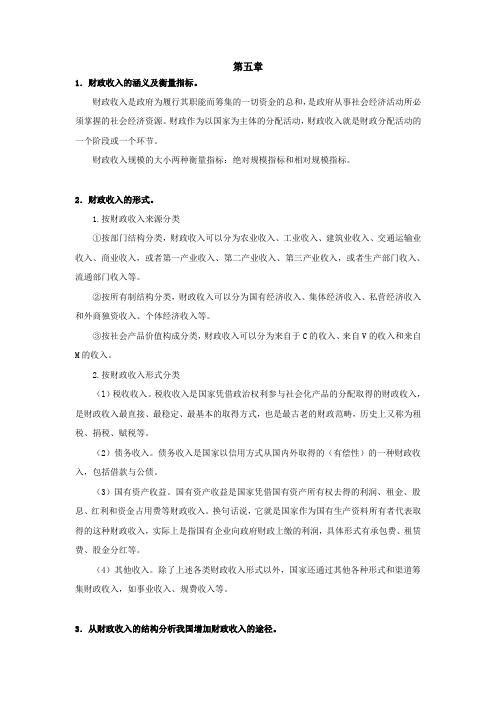
第五章1.财政收入的涵义及衡量指标。
财政收入是政府为履行其职能而筹集的一切资金的总和,是政府从事社会经济活动所必须掌握的社会经济资源。
财政作为以国家为主体的分配活动,财政收入就是财政分配活动的一个阶段或一个环节。
财政收入规模的大小两种衡量指标:绝对规模指标和相对规模指标。
2.财政收入的形式。
1.按财政收入来源分类①按部门结构分类,财政收入可以分为农业收入、工业收入、建筑业收入、交通运输业收入、商业收入,或者第一产业收入、第二产业收入、第三产业收入,或者生产部门收入、流通部门收入等。
②按所有制结构分类,财政收入可以分为国有经济收入、集体经济收入、私营经济收入和外商独资收入、个体经济收入等。
③按社会产品价值构成分类,财政收入可以分为来自于C的收入、来自V的收入和来自M的收入。
2.按财政收入形式分类(l)税收收入。
税收收入是国家凭借政治权利参与社会化产品的分配取得的财政收入,是财政收入最直接、最稳定、最基本的取得方式,也是最古老的财政范畴,历史上又称为租税、捐税、赋税等。
(2)债务收入。
债务收入是国家以信用方式从国内外取得的(有偿性)的一种财政收入,包括借款与公债。
(3)国有资产收益。
国有资产收益是国家凭借国有资产所有权去得的利润、租金、股息、红利和资金占用费等财政收入。
换句话说,它就是国家作为国有生产资料所有者代表取得的这种财政收入,实际上是指国有企业向政府财政上缴的利润,具体形式有承包费、租赁费、股金分红等。
(4)其他收入。
除了上述各类财政收入形式以外,国家还通过其他各种形式和渠道筹集财政收入,如事业收入、规费收入等。
3.从财政收入的结构分析我国增加财政收入的途径。
(1)从财政收入的价值构成角度来分析:M是产品价值中扣除补偿价值和个人消费价值之后的剩余产品价值,即新创造的、归社会支配的剩余产品的价值,它是财政收入的基本源泉。
从M的含义可以看出,政府将其作为财政收入的来源,既不会妨碍劳动力的再生产,也不会损及生产资料消耗的补偿以及企业再生产的进行。
财政学(陈共)课后习题答案详解

第一章财政概念和财政职能复习与思考1.学习财政学为什么要从政府与市场的关系说起?答:在市场经济体制下,市场是一种资源配置系统,政府也是一种资源配置系统,二者共同构成社会资源配置体系。
而财政是一种政府的经济行为,是一种政府配置资源的经济活动,所以明确政府与市场的关系是学习财政学和研究财政问题的基本理论前提。
不明确政府与市场的关系,就难以说明为什么有市场配置还要有政府配置,政府配置有什么特殊作用,政府配置的规模多大为宜,政府采取什么方式配置资源等。
什么是市场?完整的市场系统是由家庭、企业和政府三个相对独立的主体组成的。
在市场经济下,政府构成市场系统的一个主体,这是毋庸置疑的。
比如,政府为市场提供诸如基础实施、教育和社会保障之类的公共物品和准公共物品,同时从市场采购大量的投入品和办公用品。
但政府又是一个公共服务和政治权力机构,具有与市场不同的运行机制,因而在市场中又具有特殊功能和特殊的地位,可以通过法律、行政和经济等手段,“凌驾”于市场之上介入和干预市场。
因此,为了说明政府与市场的关系,需要先从没有政府的市场系统说起,这时市场只有两个主体,即家庭和企业。
2.什么是市场失灵?答:市场失灵是和市场效率对应的。
市场的资源配置功能不是万能的,市场机制本身也存在固有的缺陷,这里统称为“市场失灵”。
市场失灵主要表现在:(1)垄断。
(2)信息不充分和不对称。
(3)外部效应与公共物品。
4)收入分配不公。
(5)经济波动。
3.参考图1—1,思考政府在市场经济体制下的经济作用。
答:西方新凯恩斯主义提出一种新型的政府-市场观,认为现代经济是一种混合经济(指私人经济和公共经济),政府和市场之间不是替代关系,而是互补关系。
图1-1说明了有政府介入的市场,政府与家庭、企业之间的收支循环流程。
图 1-1 政府与家庭、企业之间的收支循环流程图我国在明确提出我国经济体制改革的目标是社会主义市场经济体制的时候,曾对社会主义市场经济体制做出一个简明的概括:“就是要使市场在社会主义国家宏观调控下对资源配置起基础性作用……。
财政学第五章财政投资性支出习题集
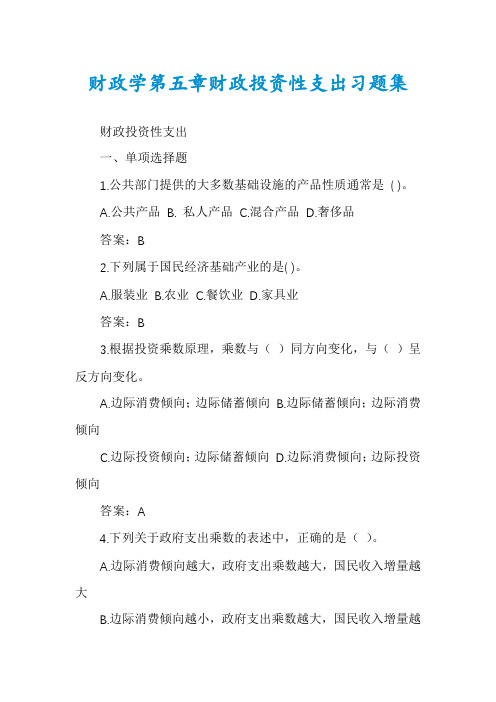
财政学第五章财政投资性支出习题集财政投资性支出一、单项选择题1.公共部门提供的大多数基础设施的产品性质通常是( )。
A.公共产品B. 私人产品C.混合产品D.奢侈品答案:B2.下列属于国民经济基础产业的是( )。
A.服装业B.农业C.餐饮业D.家具业答案:B3.根据投资乘数原理,乘数与()同方向变化,与()呈反方向变化。
A.边际消费倾向;边际储蓄倾向B.边际储蓄倾向;边际消费倾向C.边际投资倾向;边际储蓄倾向D.边际消费倾向;边际投资倾向答案:A4.下列关于政府支出乘数的表述中,正确的是()。
A.边际消费倾向越大,政府支出乘数越大,国民收入增量越大B.边际消费倾向越小,政府支出乘数越大,国民收入增量越大C.边际储蓄倾向越大,政府支出乘数越大,国民收入增量越大D.边际储蓄倾向越小,政府支出乘数越小,国民收入增量越小答案:A5.财政投融资主体是()。
A.政府B.企业C.居民D.国外公司答案:A6.以融物形式达到融资目的的筹资方式是()。
A.借贷B.抵押C.透支D.租赁答案:B7.在投资修建高速公路时,能体现出公共财政非盈利性的方式是()。
A.招标B.贷款C.引进外资D.政府补贴答案:D8.下列项目不属于投资性支出的是()。
A.财政部对于西部大开发的资金支持B.国防科工委对于两文卫星测控中心某项新技术发明的资金拨款C.国家对东南亚海啸灾害的捐款D.国家发展与改革委员会为长江三峡工程的某项技术论证所提供的资金支持答案:C9.投资性支出占财政支出比重的变动趋势是()。
A.持续上升B.持续下降C.基本保持不变D.随国际形势变化而波动财政学习题集重点答案:B 10.A.购买性支出B.转移性支出C.社会保障支出D.专项支出答案:A 11.A.银行B.金融市场答案:C 12.A.公共需要B.社会需要C.私人需求D.以上都不对答案:A 13.不会向农业投资转化。
A.大于或等于B.小于或等于C.答案:A14.要使农业部门和农户自身的积累成为农业投入的主要资金来源,其根本条件是(A.农产品的销售收入必须高于农业生产的投入成本B.农业投资的收益率高于全社会平均的投资收益率C.农产品的销售收入不高于农业生产的投入成本D.农业投资的收益率不低于全社会平均的投资收益率答案:B15.农业生产部门的特殊性主要体现在()。
财政学(南开大学)智慧树知到答案章节测试2023年
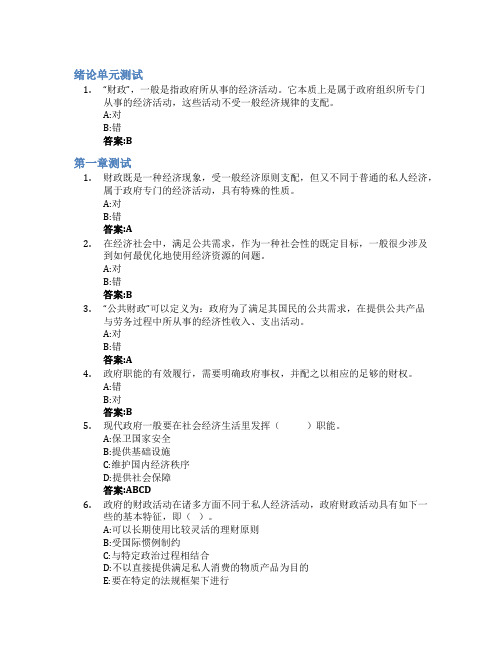
绪论单元测试1.“财政”,一般是指政府所从事的经济活动。
它本质上是属于政府组织所专门从事的经济活动,这些活动不受一般经济规律的支配。
A:对B:错答案:B第一章测试1.财政既是一种经济现象,受一般经济原则支配,但又不同于普通的私人经济,属于政府专门的经济活动,具有特殊的性质。
A:对B:错答案:A2.在经济社会中,满足公共需求,作为一种社会性的既定目标,一般很少涉及到如何最优化地使用经济资源的问题。
A:对B:错答案:B3.“公共财政”可以定义为:政府为了满足其国民的公共需求,在提供公共产品与劳务过程中所从事的经济性收入、支出活动。
A:对B:错答案:A4.政府职能的有效履行,需要明确政府事权,并配之以相应的足够的财权。
A:错B:对答案:B5.现代政府一般要在社会经济生活里发挥()职能。
A:保卫国家安全B:提供基础设施C:维护国内经济秩序D:提供社会保障答案:ABCD6.政府的财政活动在诸多方面不同于私人经济活动,政府财政活动具有如下一些的基本特征,即()。
A:可以长期使用比较灵活的理财原则B:受国际惯例制约C:与特定政治过程相结合D:不以直接提供满足私人消费的物质产品为目的E:要在特定的法规框架下进行F:通常受政府主管官员的个人风格影响答案:ACDE7.虽然在不同政治体制、经济体制的国家,政府事权、财权的规模,以及制衡方式、程度均有很大差别,但是人们普遍认识到,无论何种国家、何种条件下,政府的权限越大,()。
A:国民的自由权越小B:市场的权限越小C:市场的权限越大D:国民的自由权越大答案:AB8.人们普遍认为政府的权力应该受到必要的限制,理由是()。
A:无法保证政府官员所做各种决策总是正确的B:人类社会中任何权力都是危险的C:政府官员不会借助公众权力牟取私利D:政府权力过大会相应地破坏个人的“经济自由”答案:ABD9.下列属于公共需求的有:()。
A:国防安全B:城市空气净化C:瘟疫等重大传染病防疫D:个人商业人身保险E:新东方英语培训课程F:社会救济G:司法行政答案:ABCFG10.明确政府财政本质,有助于从()方面规范政府财政活动。
财政与金融教程-第五章 答案
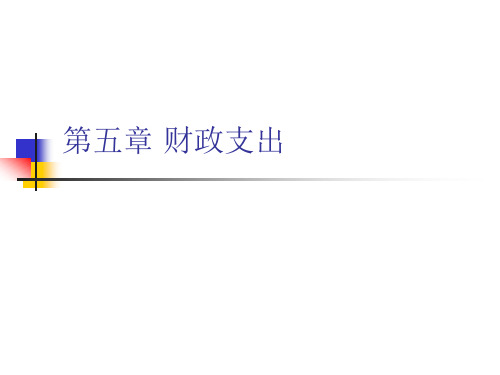
【案例分析】
竞争性谈判是指采购人或者采购代理 机构直接邀请供应商就采购事宜进行 谈判的方式。北京A数字技术有限公司 第二次报价178000元,同时承诺如果 此报价不是最低报价,将比最低报价 再降1000元,违反了公平竞争原则。
转移性支出:转移性支出又称补助支出或无偿支出,是指政府按照一定方式 把一部分财政资金无偿转移给受益人,但并不能获得相等代价的商品和劳务 的支出。
财政补贴:财政补贴是指一国政府根据一定时期政治经济形势及方针政策, 为达到特定的目的,对指定的事项由财政安排的专项资金补助支出。
社会保险:社会保险是国家通过立法采取强制手段对国民收入进行分配、筹 集专项基金,对劳动者在遇到生、老、病、伤、残等风险时获得基本生活需 要和健康保障的一种社会保障制度。
7.青藏铁路是目前世界上海拔最高、修建难度最大的高原铁路, 是人类铁路建设史上前所未有的壮举。青藏铁路格尔木至拉萨段 国家批准的工程建设总投资为330.9亿元人民币,平均每公里投 资高达2900万元人民币,我国到2000年才具有修建青藏铁路的 经济实力。为什么青藏铁路耗资那么大新中国老一辈领导人和几 代建设者一直想修建?修建支出属于财政支出中的哪类支出,有 何意义?
第五章 财政支出
【关键名词】
财政支出:通常也被称作政府支出或公共支出,是财政分配活动的第二个阶 段,是国家将通过财政收入所筹集起来的财政资金,按照实现国家职能的需 要,有计划、按比例地进行再分配,以安排使用到各项用途上去的过程。
《财政学》第5~7章课后习题

第五章财政收入总论一、名词解释财政收入国有资产收益二、填空财政收入的形式包括--------、---------、--------和--------等几种,其中--------是最重要的财政收入形势式。
三、判断1、国债是一个特殊的财政范畴,是财政收入的辅助形式。
2、经济发展水平越高,经济规模总量越大,相应地,国家的财政收入规模也较大。
3、价格的上涨会引起名义财政收入和实际财政收入的同时增加。
4、发达国家的财政收入规模往往高于发展中国家。
四、选择1、()是财政收入的基本源泉。
A、资本的转移价值CB、劳动者工资VC、剩余产品价值M2、来自于个人的财政收入形式包括()。
A、直接向个人征税B、直接向个人收取的规费收入和罚没收入C、国家出售高税率的消费品所获得的一部分收入,实际上是由v转化而来的D、居民购买的国债五、思考题分析影响财政收入规模的因素主要有哪些第六章税收理论一、名词解释税收间接税直接税中央税中央、地方共享税税收弹性税率二、填空1、税收的课税权主体是--------、税收课征的依据是--------、税收课征的对象是一部分--------或--------。
2、税收的特征包括---------、--------和--------。
3、按照课税对象的性质分类,税收分为---------、---------、--------和--------等四类。
4、税收的效率原则包括--------和--------两个方面。
5、税率有三种形式,即--------、--------和--------。
一般对流转额征税采用---------税率。
6、复税制结构的类型有三种,即--------、--------和--------。
三、判断1、税收的无偿性是以强制性为条件的。
2、税收的固无偿性既有利于保证财政收入的稳定,也有利于维护纳税人的合法权益。
3、增值税、消费税、营业税等都属于直接税。
4、各种所得税和财产税都属于间接税。
《财政学》全本课后习题答案

第一章市场失灵与财政职能复习思考题一、名词解释财政:国家为了满足社会公共需求对剩余产品进行分配而产生的经济行为。
私人商品:由市场提供用来满足个人需要的商品和服务。
公共商品:由国家机关和政府部门提供用来满足社会公共需求的商品和服务。
外部效应:指私人费用与社会费用或私人得益与社会得益之间的非一致性,或者说是某人或某企业的行为影响了其他人或企业,却没有为之承担相应的成本费用或没有获得相应的报酬。
财政职能:即财政经济职能,是指财政在一定经济模式下内在的、客观上固有的经济功能。
二、单项选择题1.财政分配的主体是(B )。
A.社会B.国家C.市场D.企业2.财政分配的主要对象是(D )。
A.社会总产品价值B.物化劳动价值C.必要劳动产品价值D.剩余产品价值3.财政分配的最基本特征是(C )。
A.强制性B.无偿性C.国家主体性D.公共性4.下列选项中,属于财政现象的是(B )。
A.企业引进外资B.企业购买公债C.企业发行股票D.企业购买金融债券5.下列关于财政收支活动的说法,正确的是(D )。
A.既包括国民收入初次分配,也包括国民收入再分配B.是指国民收入初次分配C.既不是国民收入初次分配,也不是国民收入再分配D.是指国民收入再分配6.经济学的核心问题始终是(C )。
A.经济稳定B.经济公平C.高效配置资源D.国民收入初次分配三、多项选择题1.下列选项中,属于财政收入现象的有(ACE)。
A.税收B.财政拨款C.行政性收费D.财政补贴E.国债2.下列选项中,属于纯公共商品的有(ACE)。
A.法律法规B.教育C.行政管理D.社会保障E.货币发行3.财政调节居民个人收入水平的主要手段包括(AC)。
A.税收B.发行国债C.转移支出D.投资优惠E.罚款4.政府职能包括(ACD)。
A.政治职能B.政府行为C.经济职能D.社会管理职能E.决定企业生产5.宏观经济稳定的含义有(ACE)。
A.充分就业B.经济发展C.物价稳定D.进出口相等E.国际收支平衡四、判断题1.财政分配区别于其他分配形式的根本标志是分配对象不同。
财政学课后习题参考答案.pdf
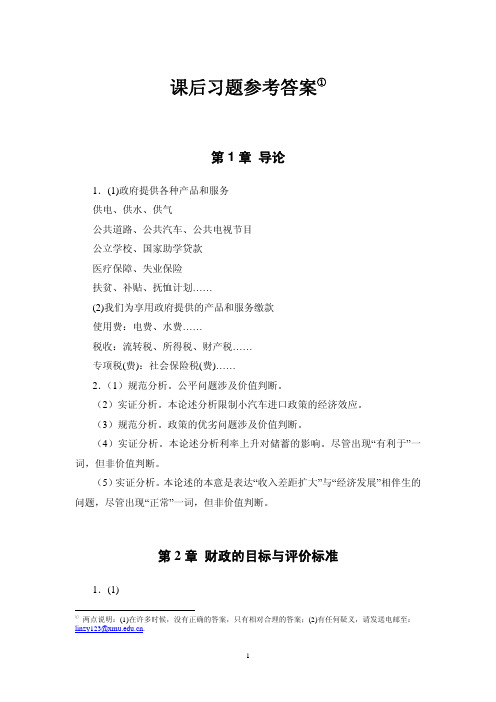
课后习题参考答案①第1章导论1.(1)政府提供各种产品和服务供电、供水、供气公共道路、公共汽车、公共电视节目公立学校、国家助学贷款医疗保障、失业保险扶贫、补贴、抚恤计划……(2)我们为享用政府提供的产品和服务缴款使用费:电费、水费……税收:流转税、所得税、财产税……专项税(费):社会保险税(费)……2.(1)规范分析。
公平问题涉及价值判断。
(2)实证分析。
本论述分析限制小汽车进口政策的经济效应。
(3)规范分析。
政策的优劣问题涉及价值判断。
(4)实证分析。
本论述分析利率上升对储蓄的影响。
尽管出现“有利于”一词,但非价值判断。
(5)实证分析。
本论述的本意是表达“收入差距扩大”与“经济发展”相伴生的问题,尽管出现“正常”一词,但非价值判断。
第2章财政的目标与评价标准1.(1)①两点说明:(1)在许多时候,没有正确的答案,只有相对合理的答案;(2)有任何疑义,请发送电邮至:linzy123@.所谓帕累托效率,指的是不可能通过资源的重新配置,达到使某个人的境况变好而不使其他任何人境况变差的结果。
或者说,不存在帕累托改善。
2.(1)在社会福利不变的情况下,牛郎增加一单位的效用可替代织女减少一单位的效用。
(2)在社会福利不变的情况下,牛郎增加一单位的效用可用来替代织女1/2 个单位效用的减少。
第3章财政的起因及其职能1.(1) 海潮的发生概率是一个常识,因此信息不对称的问题不会太大。
道德风险可能成为问题:拥有保险的人可能住得离海滩更近。
不过,防潮险市场的运行效率相对较高。
(2)无论是对消费者的医疗保险市场,还是对医生的误断保险市场来,均存在严重的信息不对称问题。
因此,这一市场是缺乏效率的。
(3)在监管到位的股票市场中,信息充分,买者、卖者众多,一般视为有效率。
(4)就个人电脑来说,信息充分,竞争充分。
不过,有些厂商可能会运用垄断势力,尤其在软件市场。
2.(1)、(2)、(3)、(4)(1)只有少数几家厂商提供电信服务,其运用垄断势力抬高服务价格。
财政学(第六版)陈共编辑课后答案
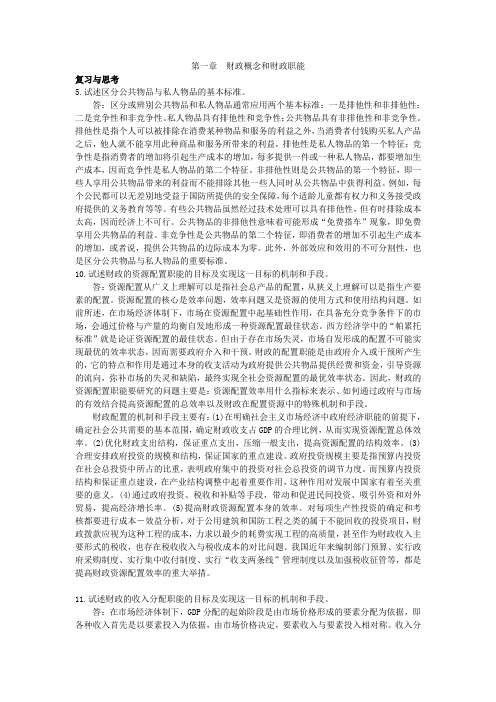
第一章财政概念和财政职能复习与思考5.试述区分公共物品与私人物品的基本标准。
答:区分或辨别公共物品和私人物品通常应用两个基本标准:一是排他性和非排他性;二是竞争性和非竞争性。
私人物品具有排他性和竞争性;公共物品具有非排他性和非竞争性。
排他性是指个人可以被排除在消费某种物品和服务的利益之外,当消费者付钱购买私人产品之后,他人就不能享用此种商品和服务所带来的利益,排他性是私人物品的第一个特征;竞争性是指消费者的增加将引起生产成本的增加,每多提供一件或一种私人物品,都要增加生产成本,因而竞争性是私人物品的第二个特征。
非排他性则是公共物品的第一个特征,即一些人享用公共物品带来的利益而不能排除其他一些人同时从公共物品中获得利益。
例如,每个公民都可以无差别地受益于国防所提供的安全保障,每个适龄儿童都有权力和义务接受政府提供的义务教育等等。
有些公共物品虽然经过技术处理可以具有排他性,但有时排除成本太高,因而经济上不可行。
公共物品的非排他性意味着可能形成“免费搭车”现象,即免费享用公共物品的利益。
非竞争性是公共物品的第二个特征,即消费者的增加不引起生产成本的增加,或者说,提供公共物品的边际成本为零。
此外,外部效应和效用的不可分割性,也是区分公共物品与私人物品的重要标准。
10.试述财政的资源配置职能的目标及实现这一目标的机制和手段。
答:资源配置从广义上理解可以是指社会总产品的配置,从狭义上理解可以是指生产要素的配置。
资源配置的核心是效率问题,效率问题又是资源的使用方式和使用结构问题。
如前所述,在市场经济体制下,市场在资源配置中起基础性作用,在具备充分竞争条件下的市场,会通过价格与产量的均衡自发地形成一种资源配置最佳状态。
西方经济学中的“帕累托标准”就是论证资源配置的最佳状态。
但由于存在市场失灵,市场自发形成的配置不可能实现最优的效率状态,因而需要政府介入和干预。
财政的配置职能是由政府介入或干预所产生的,它的特点和作用是通过本身的收支活动为政府提供公共物品提供经费和资金,引导资源的流向,弥补市场的失灵和缺陷,最终实现全社会资源配置的最优效率状态。
财政学课后作业答案(1-13章)
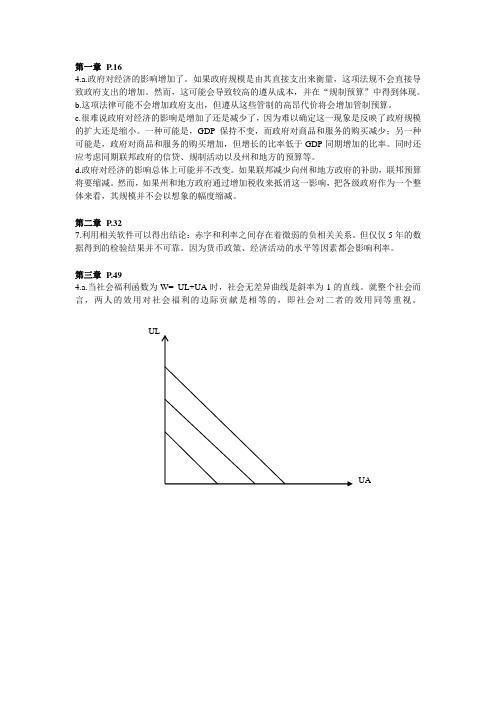
第一章P.164.a.政府对经济的影响增加了。
如果政府规模是由其直接支出来衡量,这项法规不会直接导致政府支出的增加。
然而,这可能会导致较高的遵从成本,并在“规制预算”中得到体现。
b.这项法律可能不会增加政府支出,但遵从这些管制的高昂代价将会增加管制预算。
c.很难说政府对经济的影响是增加了还是减少了,因为难以确定这一现象是反映了政府规模的扩大还是缩小。
一种可能是,GDP保持不变,而政府对商品和服务的购买减少;另一种可能是,政府对商品和服务的购买增加,但增长的比率低于GDP同期增加的比率。
同时还应考虑同期联邦政府的信贷、规制活动以及州和地方的预算等。
d.政府对经济的影响总体上可能并不改变。
如果联邦减少向州和地方政府的补助,联邦预算将要缩减。
然而,如果州和地方政府通过增加税收来抵消这一影响,把各级政府作为一个整体来看,其规模并不会以想象的幅度缩减。
第二章P.327.利用相关软件可以得出结论:赤字和利率之间存在着微弱的负相关关系。
但仅仅5年的数据得到的检验结果并不可靠。
因为货币政策、经济活动的水平等因素都会影响利率。
第三章P.494.a.当社会福利函数为W= UL+UA时,社会无差异曲线是斜率为-1的直线。
就整个社会而言,两人的效用对社会福利的边际贡献是相等的,即社会对二者的效用同等重视。
b. 当社会福利函数为W= UL+2UA时,社会无差异曲线是斜率为-2的直线。
这表明,与利维亚相比,社会两倍重视于奥古斯塔斯的效用。
c.结合效用可能性边界与社会无差异曲线,该种社会福利函数下的两种可能的最优解如下图所示。
ULUL8.当马克的收入的边际效用等于朱迪收入的边际效用时,社会福利最大化。
对已知条件中的两个效用函数求一阶导数,使MU M=MU J,则最大化条件为I J=4I M,因为固定收入是300美元,这意味着马克应该有60美元,朱迪应该有240美元,此时社会福利达到最大化。
10.a.错误。
帕累托效率的必要条件是,两种商品的边际替代率要等于其边际转换率。
财政学习题参考答案

21世纪普通高等教育规划教材财政学习题答案袁崇坚上海财经大学出版社第五章财政收入规模与结构分析一、名词解释1.根据公共财政理论,财政收入也称为“预算收入”,是指政府为履行其职能,满足公共支出的需要,依据一定的权力原则,通过财政筹措的所有货币资金的总和。
它有两层含义:一是指财政活动的过程,即政府取得财政收入的活动,以及借助这一活动介入国民收入分配的过程;二是指财政活动的结果,即政府为履行职能需要筹集的一切货币资金的总和。
二、填空题1.使用费2.教育费附加3.部门结构4.补偿形式5.预算内(资金)和预算外(资金)6.税收7.经济发展水平三、多项选择题1.ABC2.CD3.BCD4.ABC5.ABD6.ABC7.AC8.AD9.ABCD四、判断改错题1.×按财政收入形式分类包括税收、收费、债务收入、铸币收入(铸币税)和通货膨胀收入(通货膨胀税);或分为经常性收入和非经常性收入(临时性收入)两类。
2.×预算外收入中的中央政府性基金收入已纳入预算管理,其数额在预算报告中专门列明。
3.√4.×采用收费还是税收应根据政策目标和效率原则进行抉择,没有一定之规。
5.√6.×持续下降。
7.×从宏观上分析,过多的货币量是由财政赤字和信用膨胀两条渠道共同形成的,而且信用膨胀也可能是主要原因。
如果财政赤字不是通货膨胀的主要原因,那么财政在再分配中有得有失,而且可能是所失大于所得,即财政收入实际下降。
8.√9.×仅次于工业部门。
10.√五、简答题4. 我国财政收入随着经济的不断增长而增长,从总体上说,增长势头良好。
年均增速:“六五”时期为11.6%,“七五”时期为7.9%,“八五”时期为16.3%,“九五”时期为16.5%,“十五”时期为18.7%。
就财政收入本身而言,各年的增速虽然是波折的,但增长速度不算慢。
然而,相对于GDP的增长而言,则呈现明显不同的两个阶段:1995年以前表现为不断下降的趋势;从1996年开始回升,并从1998年开始表现为快速回升的趋势。
财政学(山西财经大学)知到章节答案智慧树2023年
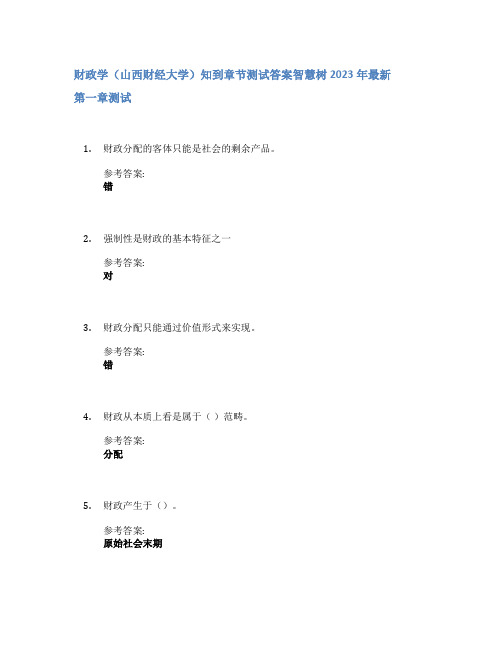
财政学(山西财经大学)知到章节测试答案智慧树2023年最新第一章测试1.财政分配的客体只能是社会的剩余产品。
参考答案:错2.强制性是财政的基本特征之一参考答案:对3.财政分配只能通过价值形式来实现。
参考答案:错4.财政从本质上看是属于()范畴。
参考答案:分配5.财政产生于()。
参考答案:原始社会末期6.公共产品的代表人物是()。
参考答案:马斯格雷夫7.财政的基本形式特征包括()。
参考答案:强制性;无偿性8.公共财政的特征包括()。
参考答案:法治性;公共性;公平性;公益性9.从状态和趋势的关系来看,经济学的研究方法包括()。
参考答案:动态分析;静态分析10.从对方法论的认识角度来看,经济学的研究方法包括()。
参考答案:规范分析;实证分析第二章测试1.具有竞争性但不具有排他性的物品是俱乐部产品。
参考答案:错2.财政职能导源于政府的经济职能。
参考答案:对3.公共选择机制与市场机制一样具有自愿性。
参考答案:错4.在决策前,由于对产品质量存在不对称信息,会产生()问题。
参考答案:逆向选择5.公式GDP=C+I+G+NX中的G是指()。
参考答案:政府的购买性支出6.下面哪一项不是“职能”的特性参考答案:具体的7.私人需要的基本特征包括()。
参考答案:内在性;分散性8.财政职能包括()。
参考答案:经济稳定;收入分配;资源配置9.判断公平分配的方法包括()。
参考答案:洛伦茨曲线;基尼系数10.公共产品的基本特征是非竞争性和排他性。
参考答案:错第三章测试1.财政支出为提高社会成员的整体文化素质提供了物质保证。
参考答案:对2.财政支出比例系数可以用来评价政府介入经济运行的规模与程度。
参考答案:对3.私人投资与财政支出效益分析法的衡量标准是相同的。
参考答案:错4.下列指标能够反映政府对国内生产总值新增部分集中和控制程度是()参考答案:财政支出边际系数5.请选择下列表述正确的选项()参考答案:所费相同,所得越多说明效益越高6.下列()主张在市场经济发展的不同阶段,财政支出会有不同的侧重点和结构组合。
财政学(第2版)习题答案

财政学(第2版)习题答案《财政学(第2版)》章节配套习题部分参考答案第一章现代国家的经济职能一、重要概念1.市场失灵:市场机制本身却存在固有的缺陷与不足,即所谓“市场失灵”,主要表现为信息不充分和不对称、垄断、外部性与公共产品、收入分配不公平和经济波动。
2.垄断:当某一行业在产量达到相对较高水平之后,就会出现规模收益递增和成本递减现象,这时就会形成垄断。
3.外部性:无法在价格中得以反映的市场交易成本或收益。
4.纯公共产品:是指每个人对这种产品的消费并不会导致任何其他人消费的减少。
5.公共需要:是当众多个人作为一个整体时所产生的需要。
6.资源配置职能:财政的资源配置职能是指财政通过参与财力分配来实现资源优化配置的职能。
7.收入分配职能:财政的收入分配职能,是指财政运用多种方式参与国民收入的分配和调节,以期达到收入分配的经济公平和社会公平。
8.经济稳定:是指通过财政政策的制定、实施与调整,对生产、消费、储蓄和投资发生影响,以达到充分就业、价格稳定、国际收支平衡等政策目标。
9-10略。
二、单项选择题1.A2.D3.A4.C5.A6.D7.A8.A9.B 10.B三、多项选择题1.ABCD2.ABC3.ACD4.ABD5.ABC6.ABCD7.CD8.BCD四、分析判断1.对2.错3.错4.对5.对6.错7.错8.错9.错 10.对五、简单分析1.什么是市场失灵?市场失灵是指市场无法有效率地分配商品和劳务的情况。
主要表现在:信息不充分和不对称、垄断、外部性与公共产品、收入分配不公平、经济波动与失衡。
2.垄断导致的效率损失表现在哪些方面?垄断导致效率损失:(1)产量受到限制,消费者福利受到额外损失;(2)垄断行业由于追求并事实存在垄断利润,缺乏尽可能降低成本的竞争压力;(3)垄断阻碍技术进步;(4)垄断者追求超额收入的寻租活动本身会造成资源浪费。
4.简述财政的基本特征。
第一,财政分配的主体是国家或政府。
第二,财政分配的对象是部分社会产品与服务。
财政学第五章公共投资项目评估练习题及答案

财政学第五章公共投资项目评估练习题及答案第五章练习题一、判断以下各陈述的正误1、投资项目是在技术上、经济上和组织上的独立的投资单位。
项目评估是为了确定一个项目的价值、质量和可取性所做的研究。
()2、公共投资项目评估就是对一个公共投资项目是否符合政府主管官员的要求所做的审定,即按照他给定的目标,测定该项目的开支规模。
()3、可供公共投资项目评估活动采用的“政府标准”,是指政府按照国民经济发展目标的要求,就公共投资项目对经济增长、社会福利、公平分配等方面的影响所提出项目评估的标准。
不过,这种评估标准主观随意性较大,也比较粗略。
()4、公共投资项目的直接成本,是指为了筹建此项目而从社会成员那里,以税收形式转移的经济资源,而社会成员消费这一公共投资项目提供的公共产品所得到全部利益就是该项目给经济生活带来的直接收益。
()5、影子价格,是指在市场交易价格不能充分反映某些产品的真正生产成本时,人们对这些产出的生产成本进行的重新估算。
()6、关于公共投资项目给生态环境造成的影响,在评估过程中通常采取“补偿变化”原则。
该原则假设,对遭项目实施损害的生态环境进行一定的货币补偿,可以使受该项目实施影响的社会成员的福利水平保持不变,则这一货币补偿就可以视为对该项目的环境影响所进行的福利损失评估的依据。
()7、公共投资项目引发要素所有者福利变动的情况类似于消费者剩余的变化,可以沿用消费者剩余分析方法来加以说明。
()8、未来收入或收益的“现值”,就是个人为换得此项收入权或收益权,而在现在愿意支付的最小现金量。
()9、在“充分就业”情况下,公共投资项目的影子工资(真实劳动成本)就应该是,该公共投资项目对劳动投入的工资支付。
()10、证明它所负责的重大公共支出项目(包括所有的各国投资项目)是有效的,不是政府预算活动的一个重要任务。
政府没有义务按照合适的方法检验自己预算项目的有效性,或绩效程度。
()二、选择题(从以下各题所给答案中挑选出所有被认为是正确的答案)1、在实行外汇管制情况下,我国官定汇率为8元人民币兑换1美元,但自由市场汇率为10元人民币兑换1美元。
财政学课后答案(完整版)

财政学课后题答案(完整版)第一章导论1.结合实际谈谈生活中的财政现象。
答案:本题的答案有很多种,但是只要从财政学的定义出发,所举例子为政府的收入、支出等财政现象均为正确答案。
比如税收、政府补助等等。
2.如何学习财政学,财政学的学习有哪些方法?答案:(1)学习财政学的基本方法为唯物辩证法。
首先首先应当正确理解掌握财政学中的一些基本概念、基本范畴,这是理解财政学一般原理的前提条件;其次,学习财政学、研究财政学应当理论联系实际。
(2)学习财政学的具体方法为实证分析法和规范分析法相结合。
(3)学习财政学应该主要比较学习,即进行中外的比较,注意辨别学习西方的财政理论知识。
第二章财政与财政职能1. 简略的财政概念。
答:财政作为一个经济范畴,是以国家(或政府)为主体的分配活动,是国家(或政府)在社会再生产过程中,通过多种收入形式,集中一部分国民生产总值或国民收入,用于满足实现其职能需要的收支活动。
2. 市场失效的主要表现。
答:(1)市场低效,它是指现实市场中存在不符合完全竞争假定条件的方面,而由于这些方面的存在,使市场机制无法实现对资源的高效配置。
主要表现在竞争失灵或垄断、公共产品的供给方面、外部效应和信息不对称等方面。
(2)市场无效,即市场配置资源的功能失效。
主要表现在偏好不合理、收入分配不公、宏观经济失调等方面。
3. 如何辨别公共产品与私人产品?并举例说明。
答:区分或辨别公共产品与私人产品的标准通常是受益的排他性或非排他性,消费的竞争性或非竞争性。
纯粹的私人产品具有排他性和竞争性,纯粹的公共产品具有非排他性和非竞争性。
公共产品的例子,只要从定义出发举例就可以,比如国防、天气预报、普通公路等;私人产品的例子,私人产品的例子不胜枚举,只要是符合定义的就好了,比如苹果、梨子等。
4. 举例说明负外部效应及其主要治理方式。
答:负外部效应(外部成本),指产品或服务给所有者以外的其他人带来了损害,但受损者同样得不到应有的损失补偿。
- 1、下载文档前请自行甄别文档内容的完整性,平台不提供额外的编辑、内容补充、找答案等附加服务。
- 2、"仅部分预览"的文档,不可在线预览部分如存在完整性等问题,可反馈申请退款(可完整预览的文档不适用该条件!)。
- 3、如文档侵犯您的权益,请联系客服反馈,我们会尽快为您处理(人工客服工作时间:9:00-18:30)。
Chapter 5 – ExternalitiesBrief Outline1.The Nature of Externalities2.Graphical Analysisa.Implicationsb.Conclusion3.Private Responsesa.Bargaining and the Coase Theoremb.Mergersc.Social Conventions4.Public Responses to Externalities: Taxes and Subsidiesa.Taxesb.Subsidies5.Public Responses to Externalities: Emissions Fees and Cap-and-Trade Programsa.Emissions Feeb.Cap-and-Tradec.Emissions Fee versus Cap-and-Trademand-and-Control Regulation6.The US Responsea.Progress with Incentive-Based Approaches7.Implications for Income Distributionsa.Who Benefits?b.Who Bears the Cost?8.Positive Externalitiesa. A Cautionary NoteAnswers to End-of-Chapter Questions1.Before passengers were charged for checked bags, they would choose whether to checkbags or carry them on based on whether they were willing to trade time for the hassle of dealing with carry-on bags. That is, passengers who valued saving time by not having to deal with baggage claim more than the cost of dealing with carry-on baggage will choose to carry on. The fact that passengers are now charged for checked baggage but not for baggage carried onto the plane will inefficiently allocate overhead space. Passengers will carry on more and bigger bags to save the fee charged, resulting in full overhead luggage containers. Overhead space will go to the first passengers on the plane, rather than being distributed more evenly. Bags checked (without a charge) at the gate forces some who would choose to carry on even without the fee to have to check, which is a loss in efficiency. Those who elect to carry on to avoid the fee, but would rather check their bags, also result in an inefficiency.2.The Coase theorem suggests that the church and the comedy club could negotiate. If thechurch possessed the right to the “noise” in the building, the comedy club could pay the church to be quiet. If the comedy club possessed the right to quiet in the building, the church could compensate the club for the noise.3.It is the case that a carbon tax would be passed on to the consumer. The tax raises coststo the producer for producing the final good. These increased costs would decrease supply, which will increase the price of that final good. In a cap and trade system, businesses must purchase permits in order to emit carbon. If the cost of purchasing and using abatement equipment is less than the cost of buying a permit, the business will use abatement equipment. In either case (buying a permit or using abatement equipment) costs for the producer increase, decreasing supply and increasing the price of the final good. If the carbon tax and the number of permits issued in the cap and trade system were set appropriately, the outlays for both programs would be the same.4.a.The number of parties per month that would be provided privately is P.b.See schedule MSB p.c.P*. Give a per-unit subsidy of $b per party to induce the correct number of parties.d.The optimal subsidy is $b. The total subsidy=abcd. “Society” comes out ahead byghc, assuming the subsidy can be raised without any efficiency costs.(Ca ssanova’s friends gain gchd; Cassanova loses chd but gains abcd, which is asubsidy cost to government.)5.The payment for signing a waiver is a negotiation as suggested by the Coase Theorem. Ifresidents accept the payment and sign the waiver, they are signaling that the noise cost to them is less than the payment. If the residents choose not to accept the payment and sign the waiver, the payment is not great enough to cover the cost of the noise. The Coase Theorem suggest in this case that further negotiation could occur.6.On the surface, the tax on saturated fat seems like a Pigouvian tax, if you assume that the$3 is equivalent to the level of the damage from the saturated fats. The commentator is not correct in his criticism that the tax is levied on an input rather an outcome. If the tax is properly set and is the direct cause of unhealthy consumers, the efficient level of saturated fat will be consumed. However, this tax suffers from the problem of assuming that the saturated fat leads directly to poor health outcomes and is the only source of unhealthy outcomes. Some consumers are healthy no matter the level of consumption of saturated fats. Others are unhealthy even with no consumption of the saturated fats. And many consumers will simply reallocate their consumption to nontaxed unhealthy foods.7.a.It is very likely that the farmer could negotiate with the neighbors, providedproperty rights are clearly defined. The Coase Theorem is therefore applicable.b.It is unlikely that negotiation could result in an efficient outcome in this case. It islikely that there are a great number of farmers involved in both harvesting antsand growing trees, making negotiation very difficult.c.Property rights are not being enforced, making negotiation through the CoaseTheorem impossible.d.There are too many people involved for private negotiation.8.a. The price of imported oil does not reflect the increased political risk byeffectively subsidizing authoritarian regimes like those in Saudi Arabia.b.The tax would estimate the marginal damage (e.g., the increased instability in theMiddle East, etc.) by importing oil from Saudi Arabia.c.The supply of TGRs is vertical at 104.5 billion if government seeks to reduceconsumption of gasoline to 104.5 billion. Consumers must have one TGR inorder to buy one gallon of gasoline, plus they must pay the price at the pump.Limiting TGRs effectively limits the demand for gasoline, so the price per gallonwill fall, but consumers must have TGRs in order to purchase gasoline. If themarket price of one TGR is $0.75, this means that supply and demand intersect at$0.75, as shown in the graph. This kind of program curbs consumption withoutgiving government more revenue because consumers are purchasing the TGRsfrom each other. However, the total amount of TGRs is limited by government.Those consumers seeking to purchase more gasoline than allowed by the initialallocation of TGRs can purchase additional TGRs from other consumers at themarket price of $0.75. By choosing to use a TGR to purchase gasoline, aconsumer incurs an opportunity cost equal to $0.75 since they cannot sell theTGR once it has been used.9. The use of the drug to treat sick cows leads to a positive externality (the benefit enjoyedby air travelers) as well as a negative externality (the costs created by a larger number of rats and feral dogs). Banning the drug might raise or lower efficiency, depending on whether the positive externality is larger or whether the negative externality is larger. There are many ways to design incentive-based regulations. Policymakers could determine the efficient level of drug usage and then either allocate or sell the right to use the drug for sick cows.10. The program matches prices to changes in demand, fluctuating as demand changes. Thisresults in higher efficiency. Drivers will respond efficiently by choosing to park based on their willingness to pay.11.a. When the Little Pigs hog farm produces on its own, it sets marginal benefit equalto marginal cost. This occurs at 4 units.b. The efficient number of hogs sets marginal benefit equal to marginal social cost,which is the sum of MC and MD. At 2 units, MB=MSC=1600.c. The efficient number of hogs sets marginal benefit equal to marginal social costs.At 3 hogs, MB=MSC=1600.12. Private Marginal Benefit = 10 - XPrivate Marginal Cost = $5TGRs$ 104.5 billion Supply of TGRsDemand for TGRs$0.75External Cost = $2Without government intervention, PMB = PMC; X = 5 units.Social efficiency implies PMB = Social Marginal Costs = $5 + $2 = $7; X = 3 units.Gain to society is the area of the triangle whose base is the distance between the efficient and actual output levels, and whose height is the difference between private and social marginal cost. Hence, the efficiency gain is ½ (5 - 3)(7 - 5) = 2A Pigouvian tax adds to the private marginal cost the amount of the external cost at thesocially optimal level of production. Here a simple tax of $2 per unit will lead to efficient production. This tax would raise ($2) (3 units) = $6 in revenue.13.a.The total cost of emissions reduction is minimized only when the marginal costsare equal across all polluters, therefore a cost-effective solution requires that MC1= MC2 or that 300e1 = 100e2. Substituting 3e1 for e2 in the formula e1 + e2 = 40(since the policy goal is to reduce emissions by 40 units) yields the solution. It iscost-effective for Firm 1 to reduce emissions by 10 units and for Firm 2 to reduceemissions by 30 units.b.In order to achieve cost-effective emission reductions, the emissions fee shouldbeset equal to $3,000. With this emissions fee, Firm 1 reduces 10 units and Firm2 reduces 30 units, but Firm 1 has to pay $3,000 for each unit of pollution theycontinue to produce, which gives them a tax burden of $3,000 x 90 (Firm 1generated 100 units in the absence of government intervention) or $270,000.Firm 2 has a lower tax burden because it is reducing emissions from 80 units to50units. Firm 2 pays $3,000 x 50 = $150,000. As the text concludes, the firmthat cuts back pollution less isn’t really getting aw ay with anything because it hasa larger tax liability than if it were to cut back more.c.From an efficiency standpoint, the initial allocation of permits does not matter. Ifthe two firms could not trade permits, then Firm 2 would have to undertake all ofthe emissions reduction. Initially, Firm 1’s MC is zero, while Firm 2’s MC is$4,000, so there is a strong incentive for Firm 2 to purchase permits from Firm 1.Trading should continue until MC1 = MC2, which is the cost-effective solution.This means that the market price for permits will equal $3,000, the same as theemissions fee. At this price, Firm 2 will purchase 10 permits from Firm 2,allowing Firm 2 to reduce emissions by 30 rather than 40 and requiring Firm 1 toreduce emissions by 10. This solution is the same as the solution achieved withthe emissions fee. However, Firm 1 is better off because instead of having to paytaxes, it will receive a payment of $30,000 for its permits. Firm 2 must pay$30,000 for the extra permits, but it also avoids the payment of taxes. Thegovernment lost $420,000 in tax revenue. The firms must still pay the cost ofemissions reduction, plus Firm 2 must pay for the permits purchased from Firm 1.14.If marginal costs turn out to be lower than anticipated, cap-and-trade achieves too littlepollution reduction and an emissions fee achieves too much pollution reduction. With an inelastic marginal social benefit function, cap-and-trade is not too bad from an efficiency standpoint, while an emissions fee causes pollution reduction to be much greater than the efficient level when marginal cost is lower than anticipated. When marginal social benefits are elastic, the opposite is true.。
